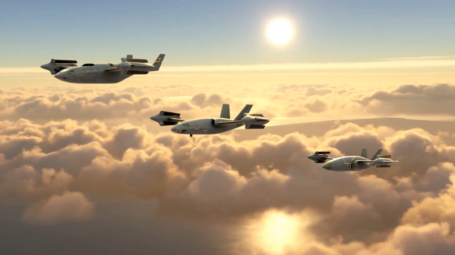Společnost Bell představila nový koncept vysokorychlostního vertikálního vzletu a přistání pro vojenské použití

Fort Worth, Texas (3. srpna 2021) – Společnost Bell Textron Inc., dceřiná firma Textron Inc. (NYSE: TXT), představila konstrukční řešení letadlových systémů pro vojenské aplikace, které budou využívat její technologii vysokorychlostního kolmého vzletu a přistání (HSVTOL). Bell tak pokračuje v inovaci nové generace strojů s kolmým vzletem. Technologie HSVTOL v sobě spojuje schopnost vrtulníků vznášet se s rychlostí a doletem stíhacího letoun.
„Technologie HSVTOL společnosti Bell představuje zásadní vylepšení pro rotorová letadla,“ uvedl Jason Hurst, viceprezident Bellu pro inovace. „Investice do těchto technologií významně snížily provozní rizika a pomohly nám při rychlém vývoji HSVTOL prostřednictvím digitálního inženýrství. K tomu jsme využili našich rozsáhlých zkušeností i úzké spolupráce s ministerstvem obrany a výzkumnými laboratořemi.“
Koncept HSVTOL společnosti Bell zahrnuje následující prvky:
- schopnost viset s nízkým vzdušným proudem generovaným hlavním rotorem vrtulníku
- cestovní rychlost 740 km/h, která je velmi podobná rychlosti proudového letadla
- skutečnou nezávislost na vzletové a přistávací dráze a velmi dobrou vytrvalost, když letoun visí
- možnost variabilní úpravy pro širokou řadu misí od bezpilotního vyprošťování osob po taktickou mobilitu
- celkovou hmotnost stroje pohybující se od 4 000 liber (cca 1 800 kg) až po 100 000 liber (přes 45 tun)
Funkce HSVTOL, kterou Bell nabízí, je naprosto klíčová pro potřeby budoucích misí. Díky nim budou stroje nezávislejší na vzletové a přistávací dráze, budou mít zvýšenou schopnost přežít, disponovat vyšší flexibilitou při nejrůznějších misích a zároveň vyšší výkonností oproti starším platformám.
V souvislosti s rozvojem technických a technologických možností konvertoplánů, pokrokům v digitálním řízení letu a novým technologiím pohonu je Bell plně připraven rozvíjet HSVTOL pro moderní vojenské mise.
Přes 85 let se společnost Bell věnuje výzkumu technologií vysokorychlostního kolmého vzletu pro letouny a stala se tak průkopníkem inovativních konfigurací VTOL, jako jsou X-14, X-22, XV-3 a XV-15 pro NASA, americkou armádu i americké letectvo. Poznatky, které Bell získal během vývoje strojů XV-3 a XV-15, významně pomohly a podpořily vývoj konvertoplánu Bell-Boeing V-22 Osprey. Ten se stal mimořádně ceněnou platformou, jež změnila způsob, jakým americká armáda provádí obojživelné útoky, infiltraci a exfiltraci na velké vzdálenosti nebo zásobování, a to díky kombinaci vysoké cestovní rychlosti a dlouhého doletu. Oba parametry dosahují dvakrát vyšších hodnot než u klasických vrtulníků, které stroj V-22 nahradil.